Oil Consumption
-
- The Cost Of Lubricating Trunk Piston Engines Maritime Reporter, Oct 1989 #16
Over the past 25 years, the specific fuel consumption for marine trunk piston engines has reduced and an increasing number of such engines are designed for residual fuel operation whether they are for main propulsion or auxiliary purposes.
The cost of fuel varies widely as the spot market price of fuel oil fluctuates. Also the cost of lubricant is an expense, which while it is not generally subject to such price variations, may be converted to a fuel equivalent value in order to better understand the running costs of a trunk piston engine.
The reduction in specific fuel consumption has taken place through evolutionary design stages and has been achieved by a general increase in pressure and temperature in the operating cycle, so making greater demands upon the ring pack. The function of the lubricant in such engines is multipurpose, it has to lubricate the cylinder to minimize wear, lubricate the bearings and running gear and cool the underpiston crown. As a result of the first function, debris from the ring pack is transported to the circulating oil and this carbonaceous matter is seen as insolubles. Treatment of the oil is carried out.by periodic makeup, filtration and also often by suitable centrifuging of the charge.
Even after all this, there is sometimes a definite trend for the insolubles burden to continue to increase so that partial or total renewal of the charge is necessary to enable the lubricant to satisfactorily perform the functions defined above. In addition, other trends have taken place which also have an effect upon the lubricant. These are the reduction of the oil charge in some designs, when expressed on a kg/kw basis and also a reduction of the lubricating oil consumption by attention to the ring pack design.
These trends have a significant effect on the oil in circulation with respect to alkalinity reserve, expressed as Total Base Number TBN mgKOH/g, and insoluble burden.
After a period of time the alkalinity reserve will stabilize at a value which is a function of the engine design, sulphur level of the fuel burnt and the oil consumption rate.
The total oil consumption related to oil change interval is shown in Fig. 1. It should be noted that the total consumption is the addition of the make up oil used and the oil used to replenish the charge when expressed on a g/kwh basis. By way of illustration two conditions are shown, condition A, which is for a design charge of 1.2 kg/kw and consumption of 1.3 g/kwh, and condition B, which is for a charge of 0.5 kg/kw and consumption of 0.6 g/ kwh. Experience has shown that for condition A oil changes under normal operating parameters are infrequent and hence the total consump- tion can be approximated to that of the make up consumption. While for condition B, oil changes are required.
The lubricating oil used, being a consumable item, can be related to fuel and this associated cost or penalty can be determined from Fig. 2 or Fig. 3, depending on whether the engine has a high or low consumption.
Usually marine lubricating oil is purchased under term contract and hence is not subject to severe price fluctuations, its price being determined by the component cost and market forces. On the other hand, fuel oil is purchased on the spot market and is subject to wide price variation. In this decade the fuel price has fluctuated in the range of $35-$220/ton. Such a variation has a significant effect on the lubricating oil fuel equivalent penalty (LOFEP) for trunk piston engines.
Determination of LOFEP is illustrated by the plotted example in Fig. 2 where the following values have been used: Total oil consumption 1.5 g/kwh; lubricating oil price, $l,600/ton; and fuel price, $90/ton.
Using these values, the procedure for determining LOFEP from Fig. 2 is as follows: (1) construct a vertical line representing 1.5 g/kwh to intersect the lubricating oil price ($l,600/ton); (2) from this intersection, construct a horizontal line to intersect the fuel price line ($90/ ton); drop a vertical line to the horizontal axis to determine LOFEP.
In Fig. 3 which is for a low consumption condition the procedure is similar to that for Fig. 2. This is illustrated with the values 0/625 g/ kwh, lubricating oil price $1,600/ ton, fuel price, $90/ton, and a cost factor of 1.0. This procedure is identical for the first two steps as described for Fig. 2. At the third step the vertical line is taken to the intersection of the cost factor line (in this case 1.0). Then from this intersection construct a horiziontal line to the vertical axis for determining the LOFEP under the plotted conditions.
The factor line, third quadrant (bottom left) in Fig. 3, allows the cost of alternative lubricants to be examined. This may be due to a change in cost because of a variation in TBN or consideration of another lubricant. The LOFEP value obtained, whether it be from Fig. 2 or Fig. 3, should be added to the specific fuel consumption in order to take account in fuel terms the effect of a particular lubrication regime.
For further information on marine lubricant products from BP Marine, Circle 96 on Reader Service Card
-
- B&W Offers Technical Paper On Advantages Of New Low-Speed Diesels Maritime Reporter, Oct 1981 #71
apply for the first time a stroke-bore ratio of 3:1. The cylinder output ranges from 690 bhp at 200 rpm to 405 bhp at 163 rpm. Specific fuel oil consumption down to 129 g/bhph is guaranteed. The largest of the new engines is the L-90 GB/E which is based on the existing and well-proven GFCA design
-
- Krupp Mak Manufactures Medium-Speed Diesel Engines For Naval Ship Applications Maritime Reporter, May 1988 #6
—Free Literature Available— A medium-speed diesel engine designed for heavy fuel operation and low fuel oil consumption is an ideal basis for engines with the load profile for naval operations. Such medium-speed engines should be designed for: continuous operation; dependability; excellent economy;
-
- New MAN B&W Diesel Engine Extends Two-Stroke Output To Lower Range Maritime Reporter, Oct 1986 #18
of only 4.4 meters, and a dry weight of 27 tons. Features that make the S26MC an attractive alternative are: low fig- ures for specific fuel oil consumption; low figures for specific lube oil consumption; secure operation on heavy fuel oil; high reliability; low maintenance costs; and low noise level
-
- DIESEL POWER REVIEW Maritime Reporter, Jul 15, 1986 #18
for exhaust valves and 15,000- 20,000 hours for piston ring packs. With fuel oils consumption generally well below 145 grams per bhphour and lube oil consumption of 1 g/bhp-h (figures valid for both engine designs), and with both the K and B types having considerable development potential for higher loading
-
- DIESEL POWER REVIEW Maritime Reporter, Jul 15, 1983 #12
for particular applications. M.A.N. - B&W DIESEL Write 57 on Reader Service Card Ten years ago, improvements in specific fuel oil consumption was one of the least important design considerations for future generations of diesel engines. This situation changed radically during the 1970's
-
- New Bulletin Describes Improved Diesel Cylinder Liner Plating Process Maritime Reporter, Aug 15, 1980 #10
, finish machined, final inspected and vacuum blasted for shipment. Advantages of the process are said to generate significant sav- ings in lube oil consumption and diesel engine maintenance for the railroad and maritime industries. For a free copy of Bulletin 580, write David A. Baldini, Teledyne Metal
-
- Wartsila: Smokeless by Common Rail Maritime Reporter, Apr 2001 #64
cartridges, and spare parts scrap. The way to avoid used lubricating oil is never to have to change the oil. That was quite easy in the past when oil consumption was high. With the introduction of the antipolishing ring the threshold became higher. However, the oil companies have responded well to the
-
- Literature Available on New Ultra-Long-Stroke Diesel From M.A.N.-B&W Maritime Reporter, Nov 1984 #14
is now available free of charge. M.A.N.-B&W reports this new engine type for the marine market will offer a combination of the lowest fuel oil consumption and lowest rpm, and the optimum in economy for shipowners. The engine's small installation measurements require a minimum of engine space
-
- Cummins Introduces New Premium Grade Lube Oil For Diesel Engines Maritime Reporter, Nov 1984 #99
. Premium Blue is specially blended to provide cold starting protection in temperatures as low as —13 F; laboratory tests have shown less oil consumption until overhaul of an engine and up to 30 percent more miles between overhauls as a result of improved lubrication and superior protection
-
- MARINE LUBRICANTS Maritime Reporter, Jul 1990 #28
lubricants are high-ash, zinc-containing oils formulated specifically to withstand the unusually heavy stresses found in high-temperature, low-oil consumption, fourcycle, highly turbocharged engines. Mobilmar 300 Series oils optimize engine life by assuring outstanding control of varnish, ring carbon
-
- Energy Policies Will Determine Future Petroleum Imports Maritime Reporter, Nov 1991 #140
. Addressing a session at the 13th World Petroleum Congress in Buenos Aires, Argentina, Charles J. DiBona said that most experts expect U.S. oil consumption to grow domestic oil production to fall, and imports to increase in the coming decade. He cited recent studies by the U.S. Department of Energy wh
-
 )
March 2024 - Marine Technology Reporter page: 42
)
March 2024 - Marine Technology Reporter page: 42versions Image courtesy Kongsberg Discovery are featured in the series, and all withstand reverse pressure, too, and can be installed into both dry and oil-? lled canisters. MacArtney introduced a space and weight-saving ø12.7 mm SubConn Nano, a Nano connector which offers a versatile and robust performance
-
 )
March 2024 - Marine Technology Reporter page: 41
)
March 2024 - Marine Technology Reporter page: 41Image courtesy Outland Technology Image courtesy Exail Image courtesy Submaris and EvoLogics Vehicles The ROV-1500 from Outland Technology represents a leap forward in underwater robotics, a compact remotely operated vehicle (ROV) weighing in at less than 40 lbs (19kg) the ROV- 1500 is easy to transport
-
 )
March 2024 - Marine Technology Reporter page: 39
)
March 2024 - Marine Technology Reporter page: 397 A 35Ah AGM lead-acid battery is tested using the West Mountain Radio CBA to show the effect of simply ? lling the battery voids with mineral oil as a compensating ? uid. The CBA is programmed to cut-off at a voltage of 10.50v. The top line (red) shows the unmodi? ed AGM battery capacity of
-
 )
March 2024 - Marine Technology Reporter page: 36
)
March 2024 - Marine Technology Reporter page: 36, Thus, there are no implodable spaces, and so are candidate and UPS, have speci? c guidelines available on their websites. cells for pressure-balanced, oil-? lled (PBOF) assemblies. This author has personally tested pouch LiPos to 20,000 psi im- Lead-Acid: The venerable lead-acid battery comes in three
-
 )
March 2024 - Marine Technology Reporter page: 35
)
March 2024 - Marine Technology Reporter page: 35.com/BPD.htm). have been tested ? Alkaline (alkaline-manganese dioxide): These prima- ry cells are available in the widest number of standard sizes, in oil-? lled bags and are commonly available around the world. This is handy to pressures of 20,000psi without if you are in a remote port and need
-
 )
March 2024 - Marine Technology Reporter page: 33
)
March 2024 - Marine Technology Reporter page: 33in the world.” How- ever, commercial success depends on many factors, not least a predictable OPEX. Over the past four years, SMD has worked with Oil States Industries to calculate cost per tonne ? gures for prospective customers. Patania II uses jet water pumps to Oil States’ Merlin riser systems
-
 )
March 2024 - Marine Technology Reporter page: 16
)
March 2024 - Marine Technology Reporter page: 16TECH FEATURE IMR Image courtesy FORCE Technology OPTIMIZING CATHODIC PROTECTION SURVEY USING NON-CONTACT SENSORS By Svenn Magen Wigen, FORCE Technology he principle behind sacri? cial anodes, which are water structures, reducing the need for frequent repairs and used to safeguard underwater pipelines
-
 )
April 2024 - Maritime Reporter and Engineering News page: 47
)
April 2024 - Maritime Reporter and Engineering News page: 47.com Powering the fleet for 60 years! HYDRAULIC NOISE, SHOCK AND VIBRATION SUPPRESSOR Noise, Shock, VibraO on & PulsaO on in Quiet, Smooth Flow Out Oil Bladder Nitrogen (blue) Manufactured by MER Equipment Three Stage Noise & PulsaO on in ReducO on Chamber (206) 286-1817 www.merequipment.com QUALITY
-
 )
April 2024 - Maritime Reporter and Engineering News page: 41
)
April 2024 - Maritime Reporter and Engineering News page: 41maritime environments: • GMDSS/NAVTEX/NAVDAT coastal surveillance and transmission systems • Offshore NDB non-directional radio beacon systems for oil platform, support vessel & wind farm applications • DGPS coastal differential global positioning systems • VHF port communication systems Nautel
-
 )
April 2024 - Maritime Reporter and Engineering News page: 38
)
April 2024 - Maritime Reporter and Engineering News page: 38, including collecting MARPOL liquid The tanker vessel Archangel, 274 meters long and 85,474 and solid waste, transporting personnel and provisions, and oil gt, was moored using the 3-ton pulling capacity of the moor- spill response services. Images courtesy Consulmar Crowley's New LNG Containerships Carbon
-
 )
April 2024 - Maritime Reporter and Engineering News page: 35
)
April 2024 - Maritime Reporter and Engineering News page: 35becoming as interconnected as onboard sys- size training materials, including micro-learning videos, gam- tems. Kongsberg Digital has integrated NORBIT’s oil spill ing apps, VR programs and online mentoring. detection system with its K-Pos DP system for simulation- “These digital methods are more effective
-
 )
April 2024 - Maritime Reporter and Engineering News page: 34
)
April 2024 - Maritime Reporter and Engineering News page: 34scenarios, but zooming in, the industry is now working on more speci? c targets. By Wendy Laursen Image above: Kongsberg Digital has integrated NORBIT’s oil spill detection system with its K-Pos DP system for simulation-based training of offshore professionals at Equinor. 34 Maritime Reporter & Engineering
-
 )
April 2024 - Maritime Reporter and Engineering News page: 32
)
April 2024 - Maritime Reporter and Engineering News page: 32? xed wind. The subsidies won’t be a plentiful, and then a second on a luf? ng jib. This reduces the time it would there won’t be the same downturn in oil and gas that made all ordinarily take, weeks, to recon? gure the wiring of an ordi- the high-spec construction vessels available at attractive rates
-
 )
April 2024 - Maritime Reporter and Engineering News page: 25
)
April 2024 - Maritime Reporter and Engineering News page: 25vessels can MSC will see up to 20 new ships deliver to carry the equivalent of 30 C-17 transports. the ? eet in the next ? ve years. This includes new oil- Our Combat Logistics Force (CLF) is the key to keep- ing our ships at sea and in the ? ght, and sustain our forces ers, towing, salvage and rescue
-
 )
April 2024 - Maritime Reporter and Engineering News page: 21
)
April 2024 - Maritime Reporter and Engineering News page: 21along with our continued support to the in a UK design ? rm working in the North Sea marine industry,” said Langford. “We continue to hire key in- oil and gas platforms, the holy grail of rigorous dividuals and partner to provide best-in-class solutions.” R conditions in offshore energy production
-
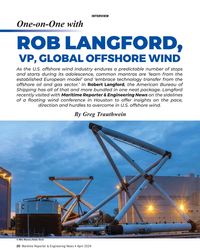 )
April 2024 - Maritime Reporter and Engineering News page: 20
)
April 2024 - Maritime Reporter and Engineering News page: 20and starts during its adolescence, common mantras are ‘learn from the established European model’ and ‘embrace technology transfer from the offshore oil and gas sector.’ In Robert Langford, the American Bureau of Shipping has all of that and more bundled in one neat package. Langford recently visited
-
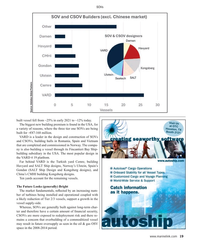 )
April 2024 - Maritime Reporter and Engineering News page: 19
)
April 2024 - Maritime Reporter and Engineering News page: 19more exposed to redeployment risk and there re- mains a concern that overbuilding of a commoditized vessel may result in future oversupply as seen in the oil & gas OSV space in the 2008-2014 period. www.marinelink.com 19 MR #4 (18-33).indd 19 4/5/2024 8:13:37 A
-
 )
April 2024 - Maritime Reporter and Engineering News page: 18
)
April 2024 - Maritime Reporter and Engineering News page: 18through dual fuel near shore Taiwanese market, which is also actively served by engines and (space for) a bunkering system. Currently metha- CTVs. Oil & gas offshore support vessels have been widely nol is a preferred energy carrier although hydrogen and liquid deployed to support construction logistics
-
 )
April 2024 - Maritime Reporter and Engineering News page: 17
)
April 2024 - Maritime Reporter and Engineering News page: 17or under construction in the North Euro- pean wind segment. Tier 2 and Tier 3 walk-to-work (W2W) vessels are cur- rently active in the segment, but as oil www.marinelink.com 17 MR #4 (1-17).indd 17 4/5/2024 8:40:33 A
-
 )
April 2024 - Maritime Reporter and Engineering News page: 16
)
April 2024 - Maritime Reporter and Engineering News page: 16charter to a wind turbine OEM or offshore wind in-built crane and gangway. farm operator to service and maintain equipment dur- ¦Tier 2: Generally, oil & gas tonnage (MPSVs, PSVs, ing the operations period of the wind farm. A typical etc.) with ? xed gangway, serving oil & gas and SOV will accommodat
-
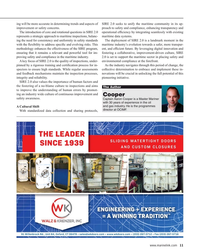 )
April 2024 - Maritime Reporter and Engineering News page: 11
)
April 2024 - Maritime Reporter and Engineering News page: 11wide culture of continuous improvement and Cooper safety awareness. Captain Aaron Cooper is a Master Mariner with 30 years of experience in the oil and gas industry. He is the programmes A Cultural Shift director at OCIMF. With standardized data collection and sharing protocols, THE LEADER SLIDING
-
 )
April 2024 - Maritime Reporter and Engineering News page: 10
)
April 2024 - Maritime Reporter and Engineering News page: 10users fully familiarize them- tion Report Program (SIRE 2.0). This initiative, led selves with the new regime, by using the portfolio of train- Tby the Oil Companies International Marine Forum ing materials and resources from OCIMF, has been key to (OCIMF), heralds a new era in vessel inspection, compliance
-
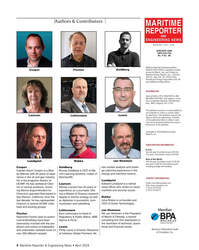 )
April 2024 - Maritime Reporter and Engineering News page: 4
)
April 2024 - Maritime Reporter and Engineering News page: 4is CEO of Ma- gic planning experience in the ter Mariner with 30 years of expe- rine Learning Systems, maker of energy and maritime sectors. rience in the oil and gas industry. MarineLMS. CONTACT INFORMATION: He is the programs director at Lundquist Email: [email protected] OCIMF. He has worked at Chev-
-
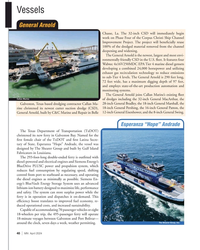 )
April 2024 - Marine News page: 40
)
April 2024 - Marine News page: 40Vessels General Arnold Chasse, La. The 32-inch CSD will immediately begin work on Phase Four of the Corpus Christi Ship Channel Improvement Project. The project will bene? cially reuse 100% of the dredged material removed from the channel deepening and widening. The General Arnold is the newest,
